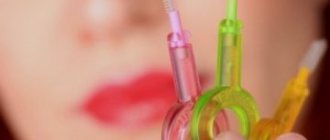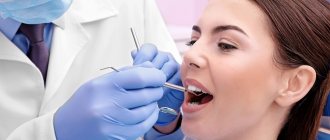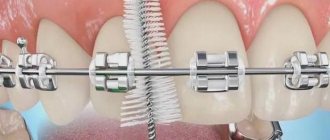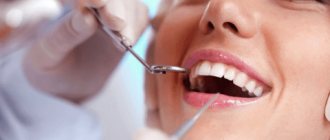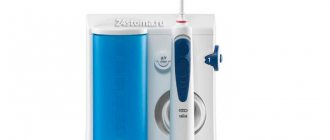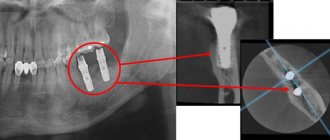Wearing braces does not replace the need to take care of your teeth. During the period of correcting the bite, the issue of hygiene arises especially acutely, because neglecting this point can lead to the development of caries. Treating teeth while wearing braces is inconvenient and undesirable, so it is better to prevent the problem than to solve it. Following simple care recommendations can significantly reduce the risk of inflammation or diseased teeth.
It is important to understand that the orthodontic structure itself in the mouth already increases the risk of plaque and tartar formation on the teeth and can cause inflammation in the oral cavity and gums. This does not mean that you need to abandon bite treatment, but it is necessary to increase attention to care issues.
Content:
- How they work
- Who needs a teeth brush?
- Classification
- What to look for when choosing
- How to use it correctly
- Yorshik is a friend of braces
Recently, dental brushes have become increasingly popular. These are special dental devices designed for the highest quality cleaning of interdental spaces. Outwardly, they are similar to standard household brushes, but they are hundreds of times smaller.
Other well-known manufacturing companies
There are many companies that produce replacement brushes. Such of them as Colgate Total, LACALUT, PRESIDENT, CURAPROX have taken strong positions in the Russian market. You can confidently trust these brands and use their products. Many of these companies use color coding for interdental brushes to make selection easier.
Thus, the German company LACALUT produces sets of orange, red, blue and yellow colors. Each color corresponds to a specific size, from S to XL according to the international classification.
The Swiss-made set from Colgate Total includes 3 sizes - 2, 4 and 5 mm. They are marked in red, blue and green colors.
The price range for brushes for brushing teeth from different manufacturers ranges from 120 to 500 rubles per set. This allows everyone to make a choice according to their income level.
To begin with, it is better to buy a starter kit with different attachments in order to evaluate the ease of use of each of them and choose the best one for yourself.
How they work
Brushes for teeth are formed by two components:
- holder;
- cleaning surface with small artificial hairs.
You can find different types of them on sale. The products differ from each other in:
- rigidity;
- quality of lint;
- method of fastening the cleaning surface;
- size of the working surface.
If the dental brush is of high quality, it will not damage mucous membranes or scratch soft tissues. After using it, your gums will not begin to bleed (however, a lot depends on the correct use of the dental accessory).
Reviews
The health of our teeth is a litmus indicator of overall health. Therefore, choosing care products is far from an idle task. The result depends on how correctly it is done.
If you already have experience using interdental brushes, please share your impressions in the comments to this article.
If you find an error, please select a piece of text and press Ctrl+Enter.
Tags: dental brushes
Did you like the article? stay tuned
Previous article
How should you use dental floss?
Next article
Dental caries: symptoms, stages of the disease and photos
Who needs a teeth brush?
The product improves oral hygiene and is therefore useful to absolutely anyone. It is especially important for people to use it:
- who have braces installed;
- wearing leveling plates;
- prone to rapid formation of plaque and tartar;
- with large interdental spaces;
- with malocclusions that do not allow proper oral hygiene;
- those suffering from frequent gum disease;
- with crowded teeth;
- with hard-to-reach indigenous units;
- accustomed to drinking coffee;
- addicted to tobacco.
If a person buys a dental brush, he will not go wrong. This device will immediately become his favorite assistant. Be sure to try it!
Indications
A brush is an additional device for dental care, but dentists recommend that some categories of people use it. The main indications for use of the product are:
- wearing braces, dentures, implants and other orthodontic and orthopedic structures;
- large spaces between molars;
- crowding and irregular shape of crowns;
- presence of malocclusion and gum disease;
- discoloration of enamel due to smoking, consumption of products with dyes;
- accelerated formation of bacterial plaque due to impaired acid-base balance in the oral cavity.
In addition, it is advisable to use a brush daily to prevent various dental diseases, as an addition to a brush.
Read how much it costs to insert a tooth and what the cost of prosthetics is made up of. Click here if you are interested in how you can restore tooth enamel at home.
At this address https://dr-zubov.ru/lechenie/desny/v-chem-prichina-i-chto-delat-otoshla.html you will learn what to do if the gum moves away from the tooth.
Classification
Conventionally, all existing dental brushes can be divided into three large groups:
- Cylindrical. Along the entire perimeter of the working part there are fibers of the same length. They are optimal for caring for large spaces between teeth and gums. Allows high-quality processing of the necks of units covered with crowns.
- Cone-shaped. The bristles on such devices are arranged in the shape of a cone. The long ones are at the base, the short ones (about one millimeter) are at the top. Cone-shaped brushes should be used to remove plaque from narrow interdental areas. They are an excellent alternative to floss.
- Curved. Made in the form of a semi-oval. Designed for the care of braces and plates. Due to the unusual shape, they easily pass between the fastenings of the orthodontic apparatus and quickly sweep out all food “deposits” from the lock.
In pharmacies you can find brushes with forked bristles at the tips. They are more effective than classic ones. This should be kept in mind when making a purchase.
Varieties
There are three types of brushes based on the shape of the head.:
- Cylindrical devices are characterized by the same length of bristles over the entire surface of the working head. Effectively cleans the lateral edges of teeth at wide intervals and the neck of implants. They have a gentle massage effect on the gums.
- Cone-shaped brushes have a tapering shape. Long bristles are located at the base of the head; towards the apex their length decreases to 1 mm. The use of tools of this form allows you to clean the gaps in the normal arrangement of the elements of the dentition.
- Curved brushes are designed for cleaning orthodontic structures. They are characterized by a semicircular shape of the handle and head, due to which they penetrate into the narrow space between the structural elements and the crown.
Such devices are convenient to use for high-quality cleaning of brace system locks. In some models of curved brushes, the tips of the bristles are forked. This contributes to a more thorough removal of plaque from the surface of the crown and orthodontic system.
Depending on the length of the bristles, the following types of brushes are distinguished:
- with long bristles - recommended for use when there is a large distance between the molars and the presence of diastemas;
- with medium bristles - the devices are designed for the standard arrangement of elements of the dentition;
- with short villi should be used in case of severe crowding of crowns.
What to look for when choosing
You need to choose a brush that suits you. You should not rely on the preferences of relatives or friends. After all, how the product will work depends 50% on the characteristics of the bite and the condition of the teeth. It is imperative to pay attention to:
- Length of the working surface. There are five sizes. The appropriate one depends on the age of the future user. Small children should use devices marked S - they have a very short working part. The longest brushes are marked XL. Without consulting a dentist, it is very difficult to understand what size will be optimal. You'll have to resort to trial and error. You don't need to do that. You should consult your doctor. He will study the width and height of dental crowns, the features of their location and name the ideal length of the brush.
- Pile length. It should be determined taking into account the width of the interdental spaces. If there is severe crowding, options with 1 mm pile are suitable. For trema and diastemas, you need to take a size of 3 mm. But you should know that short-haired models are more versatile. You can safely buy them to clean your braces.
- Hardness indicator. There are only two of them: soft pile and hard. The first is designed for children, people with tooth sensitivity and gum disease.
- Handle material. The handle can be plastic or metal. If periodontal tissues are damaged, it is better to give preference to the first. Metal bases more often injure mucous membranes.
- Handle size. Here you can focus solely on your own preferences. Some people like it when the handle is long, others like it when it is short. The handle does not affect the quality of hygiene measures taken.
Dentists do not recommend choosing dental brushes based on cheapness. Very often the cheapest products turn out to be of poor quality. It is better to give preference to products from trusted companies. Then the risk of damaging your gums and enamel will be much lower.
General concept
The brush for cleaning teeth looks like a household analogue for cleaning bottles with a narrow neck, reduced by tens of times.
It is made of high-quality hypoallergenic materials: the fibers are made of nylon, and the rod is made of a medical alloy that does not lend itself to oxidation.
The device consists of two elements:
- handle holder , which can be long or short;
- working part containing bristles for cleaning the interdental space.
In addition to cleansing the intercoronal spaces, the brush performs a massage function. Under its influence, blood circulation in periodontal tissues improves and strengthening occurs.
Dental brushes are recommended for use in the presence of orthodontic structures in the oral cavity. The device can penetrate under the recesses and bends of bracket systems and bridge structures, removing food debris and accumulated plaque.
How to use it correctly
Even a small child can figure out how to treat the interdental spaces with a brush. The order of its use is as follows:
- Brush your teeth with paste and brush.
- Rinse your mouth thoroughly.
- Rinse the brush under running water.
- Place it in the area to be cleaned and begin to make rotating or sweeping (back and forth) movements.
- Perform a final mouth rinse and rinse the dental appliance.
It is very important to hold the accessory at a right angle to the surface being treated. After insertion into the interdental gap, you should not put too much pressure on the gums. The pile should easily pass between the teeth and “appear” on the opposite side. If this turns out to be impossible, you need to buy a replacement with a smaller diameter of the working part.
During cleaning, it is advisable to periodically rinse your mouth. Then it will be possible to process in detail all the hard-to-reach places.
The brushes are reusable. Therefore, after each use they need to be washed and dried. They should be stored with a protective cap.
If the pile has lost its rigidity or shape, the brush must be disposed of. These signs indicate that its service life has come to an end.
Attention! During the first few cleanings while using the device, your gums may bleed. As soon as the body adapts to this hygiene routine, the problem will disappear. If it persists, you need to make sure that:
- no oral diseases;
- the brush is chosen correctly;
- cleaning is carried out in compliance with safety rules.
Description
In appearance they are similar to the tools used for washing bottles. Only they are smaller in size and made of soft and safe material. The devices are sold as a set, which includes attachments and holders. The attachments are usually removable, but there are also solid options. Judging by reviews from dentists, oral care products are comfortable.
There are devices for implants that do not scratch the surface, as they are coated with a special coating. Different models differ in the density of the bristles, the size of the base and the material from which the rod is made. Manufacturers produce many different devices, so there is something suitable for everyone.
Yorshik is a friend of braces
People who have braces installed are in greater need of “brush” hygiene than others. For them, brushing their teeth is always a big problem. Residues of food get stuck inside the locks and under the metal arc. It is almost impossible to remove them from there with floss or a regular brush.
Armed with a miniature assistant, a person quickly removes all food deposits and plaque. This reduces the likelihood of developing caries.
When using braces, tapered and curved brushes should be used. Due to their small diameter and unusual shape, they easily pass between small parts.
Ideally, a person with a malocclusion device should carry a brush with him everywhere. In the morning and evening it should be used after brushing. After each meal, use it to remove any unwanted food particles. Then, by the time the braces are removed, the appearance of the renewed smile will be ideal; new carious cavities will not form during orthodontic treatment.
Products of the company Oral-B (Oral Bee)
Brushes belong to the category of hygiene products and allow you to maintain a healthy oral cavity.
All produced models are completed in sets and packed in special containers. If you need to take them with you on the road, this is very convenient.
They are produced in different shapes - cylindrical and conical.
A standard set of 6 cylindrical brushes is made for the narrowest gaps between teeth. They bend easily and penetrate into the most remote corners where a regular brush cannot cope with the task. Size 2.7 mm.
What is the best electric toothbrush for children aged 10 years and older? Let's find out.
In this article, we have prepared for you reviews of Listerine mouth rinse.
Here: https://www.vash-dentist.ru/krasota-i-uxod/zubnyie-pastyi/opisanie-parodontaks.html - they will tell you whether the price of Parodontax toothpaste is justified.
The conical brush set also includes a set of 6 nozzles. The cone-shaped head with small bristles is good for people with “sparse” teeth when the spaces between them are too large. Size 3-6.5 mm.
An assorted set is also offered, which includes one interdental brush and a starter set of two interchangeable attachments - conical and cylindrical brushes.
Nylon bristles do not scratch enamel, effectively removing dirt.
Advantages
This design has many advantages:
- can be used daily;
- does not injure gums;
- perfectly cleans inconvenient areas;
- this is an excellent means of maintaining the cleanliness of crowns, implants, and orthodontic products;
- the product is easy to use;
- does not take up much space;
- There are varieties of brushes for people with different dentures;
- you can choose a product with fibers of the required length and level of hardness;
- bristles are used for a long time;
- The device is used to care for healthy and diseased teeth.
Judging by the reviews, dentists advise choosing the device carefully. Only then will it allow you to perform high-quality oral care.
Why do you need dental floss?
The American Dental Association found that the clinical effectiveness of dental floss has not been definitively proven, but there are also no strong hypotheses that prove otherwise. While waiting for the next tests, you can be guided by known knowledge. All teeth have 5 planes. With a regular brush, you can clean only three well. The remaining areas must be thoroughly cleaned with a thread or brush. It is also recommended to have a professional cleaning at the dentist 1-2 times a year (you can find out more here).
